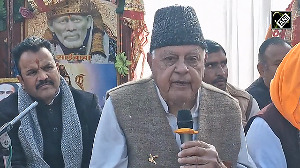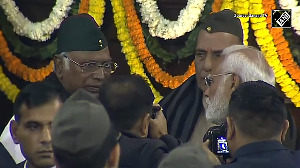For a sport which can count Mary Queen of Scots among its earliest converts, golf has taken its time to cotton on to women's involvement in the professional game.
Many clubs around the world -- Augusta National, home of the U.S. Masters, among them -- still reject female members and cordon off their plushest bars as purely male preserves.
Britain's Lee Westwood, a former European number one, still recalls his days as a young prospect when he was driven to matches by his mother who was then barred from joining him in the clubhouse.
Many of those clubs in Westwood's native central England are little changed from those days of 20 or so years ago and would sooner close up for business than let a woman on to the competition committee.
Margaret Thatcher was British Prime Minister from 1979-1990 and Hillary Clinton could be a future president of the United States but a female rules secretary at the local golf club? Not on your Nelly.
Strange, then, that organisers of tournaments worldwide suddenly appear to be jumping all over each other in a rush to attract the fairer sex to their events.
First, we had women's world number one Annika Sorenstam causing virtual apoplexy among some of the PGA Tour field by competing at last May's Colonial tournament.
Fiji's Vijay Singh, now the world number two, could not believe his eyes and pronounced the Swede's participation as definitely a Bad Thing. Many others agreed.
The end of the western world as we know it did not arrive, however.
GLITTERING CAREER
The brave Swede, soaking up 10 times more publicity than she has ever attracted in a glittering career in the women's ranks, played beautifully from tee to green at the Colonial but putted like a drain and missed the halfway cut by four shots.
Sorenstam has since called quits on any idea of joining the men's circuit on a more permanent basis but her example seems to have planted a less-than-subtle seed of thought for any tournament promoter with an eye for easy and copious publicity.
In rapid succession this year, we have had three more women lined up alongside the men. Fourteen-year-old prodigy Michelle Wie competed in January's Hawaiian Open on the PGA Tour, and narrowly missed the cut by a stroke.
Last week, 40-year-old Laura Davies also jumped on the bandwagon, becoming the first woman to play on the European and Australasian tours in the joint-sanctioned ANZ Championship in Newcastle, Australia. She also missed the cut.
Davies was a fine player in her time but it has been seven years since she last won a major championship and was happy to confess in Australia last week that her game was in no kind of shape for a serious run at the title.
The promoter, though, will have no complaints. Davies, a consummate performer, gave a string of entertaining press interviews and pulled in the punters for curiosity value, if nothing else.
While Davies struggled with her putting stroke in Newcastle, a promoter of the South African Tour Championship was busy announcing plans for another 14-year-old, the country's leading amateur Ashleigh Simon, to play in his event this week.
LITTLE IMPACT
Simon, like Wie before her, will doubtless put on a good show but - surprise, surprise -- news of her appearance alongside the men failed to make an impact much further than the borders of her native country.
The game's top male players still get steamed up over the issue, with Ernie Els and Greg Norman recently speaking out against women competing with the men while Nick Faldo gave qualified support.
Less than a year, though, after Sorenstam's Colonial appearance, the notion of women playing in men's tournaments has become distinctly old hat.
Golf promoters have one objective only and that is to drum up interest in their tournament.
Unless a woman can make a serious impact in a PGA or European Tour event and challenge seriously for the title, this trend could disappear as quickly as it emerged.
Sport, in the final analysis, is about competition -- serious competition. At present, women playing in men's tournaments do not offer that and are only there for novelty value.
One suspects that not even the reckless Mary Queen of Scots, a regular player on the burgeoning Scottish links of the 1500s until her career was cut short after upsetting Queen Elizabeth I, would have bought into this one.









 © 2025
© 2025